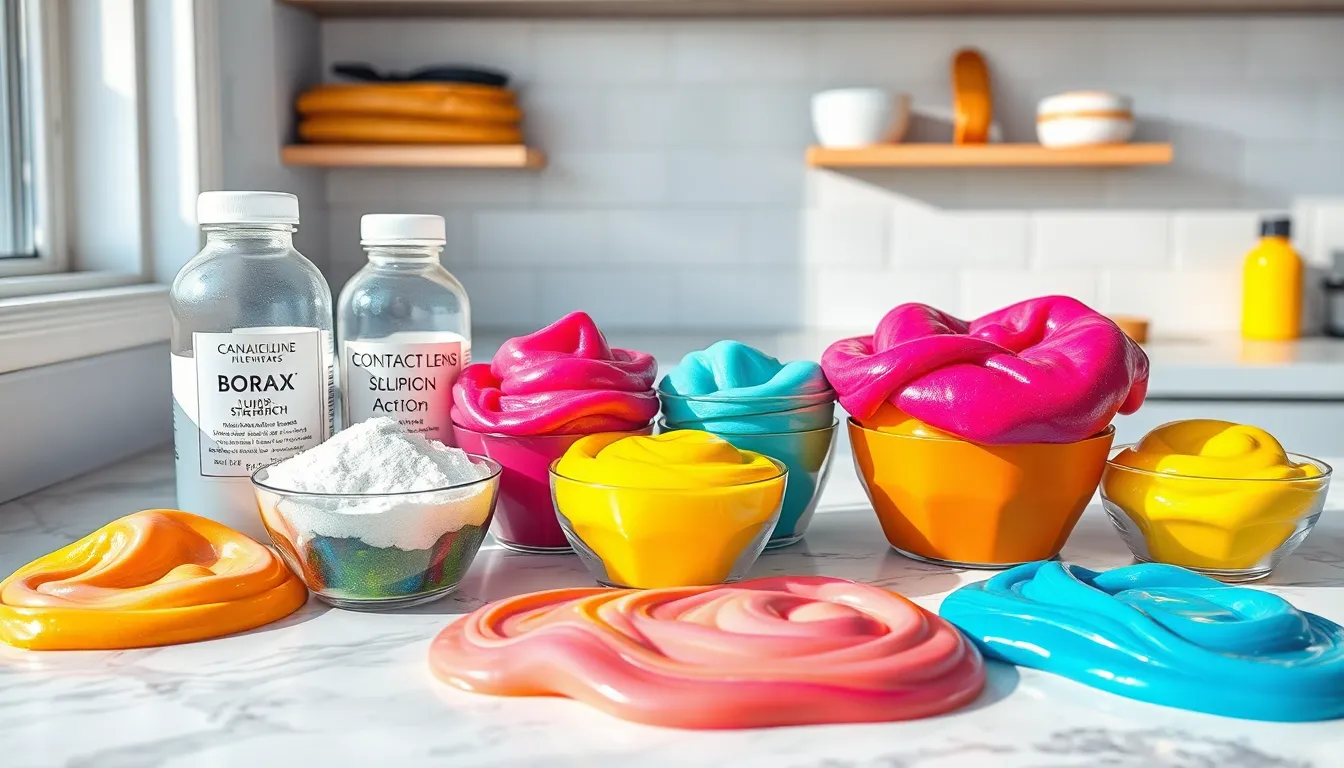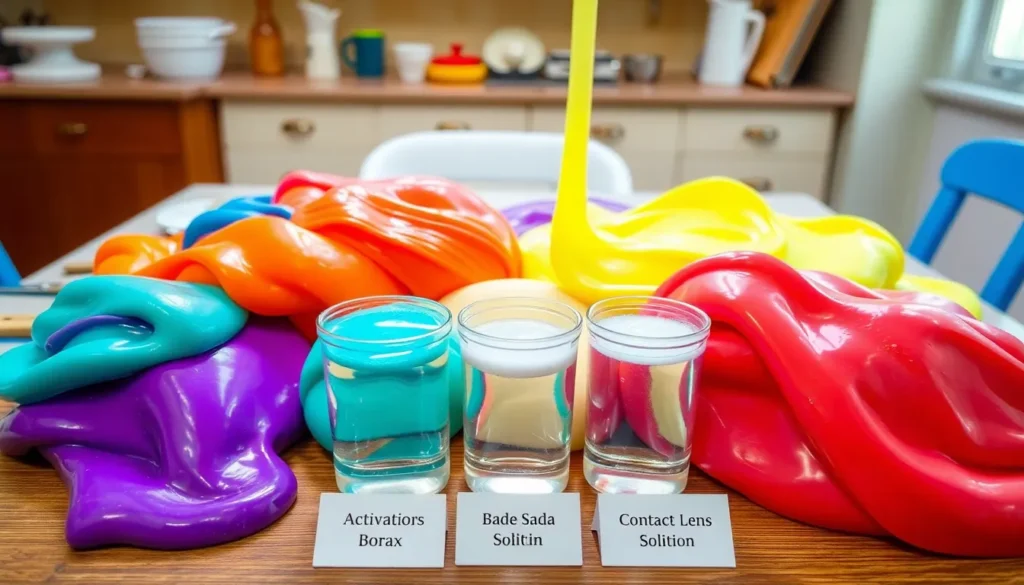Table of Contents
ToggleSlime lovers unite! Whether you’re a seasoned slime connoisseur or a curious newbie, understanding the secret ingredient behind that gooey goodness is essential. Enter the activator—slime’s magical partner in crime that transforms a simple mixture into a stretchy, squishy masterpiece. Without it, your slime dreams could quickly turn into a sticky nightmare.
What Is Activator for Slime?
Activator for slime serves as the essential component that turns a mix of glue and water into the beloved, stretchy substance many enjoy. This ingredient typically consists of a solution that includes borax, contact lens solution, or baking soda, each interacting with other substances to create the desired consistency.
Borax, often used in powdered form, effectively cross-links the glue’s polymer chains, solidifying the mixture into slime. Some prefer contact lens solution because it offers convenience and efficiency, easily transforming glue into slime without much fuss. Baking soda can also act as an activator when combined with contact lens solution, producing a soft, fluffy texture.
Different recipes may call for varying amounts of activator. Too little may result in a sticky mess that fails to hold shape, while too much may lead to a rubbery texture. Many slime enthusiasts experiment with ratios to find that perfect balance.
Moreover, activators can influence slime’s final properties. When experimenting, one factor to consider is whether the slime remains stretchy or if it turns firm and difficult to mold. Color and scent additives can also enhance the experience, but the activator remains the critical ingredient driving the transformations.
Understanding activator types and their roles in slime-making helps both newbies and veterans achieve ideal results. Each activator type contributes uniquely to the slime’s texture and properties, making it vital for successful creations.
Types of Activators

Understanding the types of activators is crucial for creating the perfect slime. Each activator provides distinct effects on the slime’s consistency and texture.
Borax
Borax serves as a classic activator in slime recipes. Known for its effectiveness, it cross-links glue’s polymer chains, resulting in a sturdy, stretchy slime. Typically, one tablespoon dissolved in water suffices for about a cup of glue. This combination ensures a strong and cohesive slime texture. While using Borax can yield fantastic results, it requires caution, as it can be irritating to the skin and eyes. Safety measures like wearing gloves are advisable when handling.
Liquid Starch
Liquid starch offers a convenient alternative to traditional activators. It simplifies the slime-making process by easily blending with glue to create smooth slime. Slime enthusiasts often prefer it for its quick activation. Typically, a 1:1 ratio of liquid starch and glue is recommended to achieve an optimal texture. This activator provides a softer, more malleable slime compared to Borax. Liquid starch also eliminates the need for additional mixing steps, making it ideal for beginners seeking straightforward recipes.
Contact Lens Solution
Contact lens solution serves as a popular and versatile slime activator. It’s useful primarily due to its compatibility with baking soda, which enhances slime’s consistency. A common mixture includes one tablespoon of baking soda combined with one to two tablespoons of contact lens solution. This combination yields a stretchy, fluffy texture prized by many. Furthermore, this type of activator is easily accessible and safer for children, making it a preferred choice among parents. Combining it with different colors or glitter allows for creativity in slime-making.
How Activators Work
Activators function as crucial agents in slime-making, driving chemical reactions that transform basic glue mixtures into stretchy, squishy textures. Their interaction with glue determines the final properties of the slime.
Chemical Reactions
Chemical reactions occur when activators mix with glue, facilitating a process known as cross-linking. Borax creates strong connections between polymer chains in the glue, enhancing durability and stretchiness. When using contact lens solution, a mild acid helps neutralize the glue, allowing for easier manipulation without compromising texture. Baking soda, when combined with contact lens solution, further modifies the chemical structure, resulting in softer slime. Understanding these reactions is essential for achieving the right consistency in slime.
Texture and Consistency
Texture and consistency largely depend on the amount and type of activator used in the slime recipe. Proper ratios lead to stretchy, pliable slime, while too much activator can produce a rubbery texture. For instance, borax typically yields a firmer slime, enhancing stability and moldability. Alternatively, using liquid starch often results in a softer, more flexible slime that’s easy to handle. It’s vital for creators to experiment with different activators, as each influences the slime’s final feel and elasticity uniquely.
Common Recipes Using Activators
Activators are pivotal in crafting various slime types. Here are two popular recipes utilizing these essential ingredients.
Basic Slime Recipe
Creating basic slime requires minimal ingredients. Combine 1 cup of school glue and 1 cup of water in a bowl. Add 1 teaspoon of baking soda, mixing until dissolved. Gradually incorporate the activator, such as contact lens solution, in small increments. Continue stirring until the slime begins to form. Knead the slime with hands to achieve the desired consistency. This simple recipe yields a fun and stretchy slime ideal for beginners.
Fluffy Slime Recipe
Fluffy slime offers a light and airy texture. Start with 1 cup of white school glue and mix with 1 cup of shaving cream. Add 1 teaspoon of baking soda for stability. Slowly pour in contact lens solution, ensuring it fully incorporates into the mixture. Knead the slime until it becomes soft and fluffy. Optionally, food coloring can enhance its appeal. This recipe creates a whimsical slime that’s enjoyable for all ages.
Activators play a pivotal role in the slime-making process. They not only determine the texture and stretchiness but also influence the overall success of the slime. By understanding the different types of activators and their unique properties, creators can tailor their slime to achieve the perfect consistency.
Experimentation with various activators like borax, liquid starch, and contact lens solution opens up a world of possibilities. Each option brings its own benefits, allowing slime enthusiasts to craft everything from sturdy to fluffy textures. With the right knowledge and a bit of creativity, anyone can master the art of slime-making and enjoy endless fun with this popular craft.





